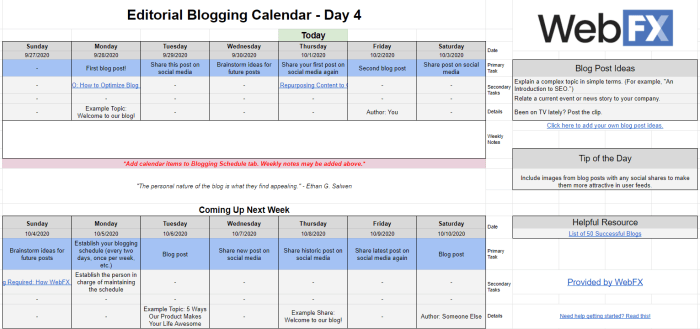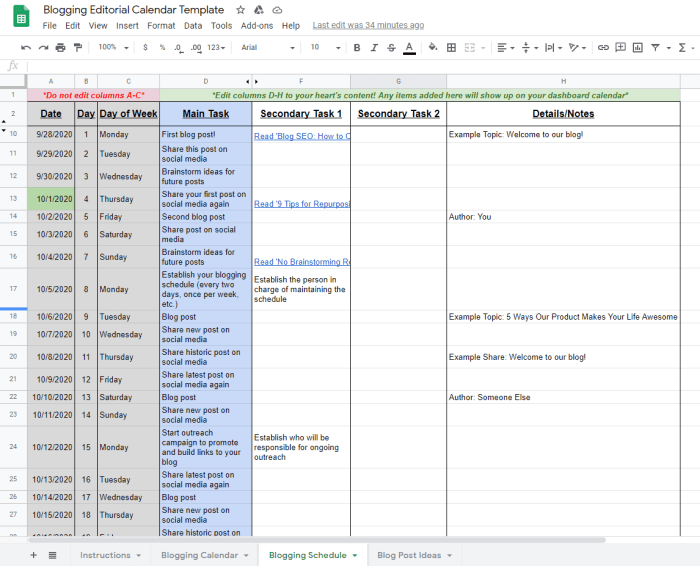Creating a Blog Editorial Calendar sets the stage for effective content planning and organization. Dive into the world of structured scheduling to boost your blog’s consistency and success.
Learn the ropes of creating, planning, and tracking content to elevate your blogging game with finesse.
Importance of Editorial Calendar

Having an editorial calendar for your blog is like having a roadmap for your content journey. It’s crucial because it helps you stay organized, plan ahead, and stay consistent with your publishing schedule.
Benefits of Using an Editorial Calendar
- Keeps you organized and on track with your content strategy.
- Helps you plan ahead for important events, holidays, or promotions.
- Allows you to see the big picture of your content and identify any gaps or areas for improvement.
- Improves collaboration with team members or contributors by providing a clear overview of upcoming content.
How Editorial Calendar Improves Consistency
- Ensures you have a consistent publishing schedule, which can help build trust with your audience.
- Reduces the stress of last-minute content creation by having a plan in place.
- Helps you maintain a consistent brand voice and messaging across all your content.
- Allows you to track and measure the performance of your content more effectively.
Creating an Editorial Calendar
Creating an editorial calendar is essential for maintaining consistency and organization in your content creation process. It helps you plan ahead, stay on track with deadlines, and ensure that your content aligns with your overall marketing strategy.
Steps to Create an Editorial Calendar
- Start by outlining your content goals and objectives. What do you want to achieve with your content?
- Identify your target audience and understand their preferences and interests.
- Brainstorm content ideas based on your goals and audience research.
- Determine the frequency of your content publication (daily, weekly, bi-weekly, etc.).
- Create a calendar template using tools like Google Sheets, Trello, or editorial calendar plugins.
- Map out specific topics or themes for each content piece and assign deadlines to ensure timely completion.
Tips for Organizing Content Ideas in the Calendar
- Categorize content based on themes, formats, or target audience segments to maintain variety.
- Use color-coding or labels to differentiate between different types of content (e.g., blog posts, videos, podcasts).
- Include details like s, call-to-actions, and relevant links within the calendar for each content piece.
- Regularly review and update your editorial calendar to reflect any changes in your content strategy or business goals.
Best Practices for Structuring the Calendar
- For blog posts, include titles, meta descriptions, s, and publishing dates in your calendar.
- For videos, Artikel scripts, shooting schedules, editing timelines, and release dates to stay organized.
- For podcasts, plan episode topics, guest interviews, recording sessions, and publication dates in advance.
- Consider integrating social media promotion schedules and email marketing campaigns within your editorial calendar for cohesive content distribution.
Content Planning

Planning content using an editorial calendar is crucial for maintaining consistency and organization in your blog. By mapping out your topics and deadlines in advance, you can ensure a steady flow of high-quality posts that resonate with your audience.
Setting Realistic Publishing Schedules and Deadlines
When setting publishing schedules and deadlines on your editorial calendar, it’s important to be realistic about your capabilities and resources. Consider factors like your writing speed, research time, and other commitments to avoid overwhelming yourself. Remember, quality is key over quantity.
- Break down larger projects into smaller tasks with specific deadlines.
- Allocate buffer time for unexpected delays or revisions.
- Consider your audience’s preferences and peak engagement times for optimal publishing.
Incorporating Seasonal or Trending Topics
To keep your content fresh and relevant, consider incorporating seasonal or trending topics into your editorial calendar. By staying up-to-date with industry news and social media trends, you can capitalize on popular topics that are likely to drive traffic to your blog.
- Monitor social media platforms, news outlets, and industry publications for emerging trends.
- Create a content bank of evergreen topics to supplement seasonal or trending content.
- Plan ahead for holidays, events, or industry-specific milestones to align with your editorial calendar.
Collaboration and Communication: Creating A Blog Editorial Calendar
In the realm of content creation, collaboration and communication are key components to success. An editorial calendar serves as a central hub for team members to coordinate efforts, stay on track with deadlines, and ensure everyone is aligned with the overall content strategy.
Facilitating Collaboration
- Assigning tasks and deadlines: An editorial calendar allows team members to see who is responsible for what content and when it needs to be completed, promoting accountability and transparency.
- Sharing ideas and feedback: With a centralized platform, team members can easily share ideas, provide feedback, and collaborate on content creation in real-time.
- Tracking progress: By having a clear overview of all content pieces in the pipeline, team members can track progress, identify bottlenecks, and adjust timelines accordingly to ensure timely delivery.
Effective Communication Methods, Creating a Blog Editorial Calendar
- Commenting and tagging: Utilizing features within the editorial calendar to leave comments, tag team members, and provide specific feedback can streamline communication and keep everyone in the loop.
- Regular check-ins: Scheduling regular check-in meetings or virtual stand-ups to discuss progress, address any challenges, and ensure everyone is on the same page can enhance communication and collaboration.
- Utilizing chat tools: Integrating chat tools like Slack or Microsoft Teams within the editorial calendar can facilitate quick discussions, brainstorming sessions, and decision-making processes.
Tools for Collaboration and Communication
- Google Calendar: Integrating Google Calendar with your editorial calendar can help team members stay organized with deadlines, meetings, and content schedules.
- Trello: Using Trello boards to visualize content workflows, assign tasks, and track progress can enhance collaboration and communication within the team.
- Asana: Asana’s project management features enable team members to create tasks, set deadlines, and communicate effectively, all within the editorial calendar platform.
Tracking and Analyzing Performance
In the world of blogging, it’s crucial to track and analyze the performance of your content within your editorial calendar. This allows you to understand what is resonating with your audience, what is falling flat, and how you can improve your future content strategy.
Key Metrics to Monitor
- Page Views: Keep an eye on how many views each piece of content is receiving. This can help you identify popular topics.
- Engagement: Look at metrics like comments, shares, and likes to gauge how your audience is interacting with your content.
- Conversion Rate: Track how many readers take action after consuming your content, such as signing up for a newsletter or making a purchase.
- Bounce Rate: Monitor how many visitors leave your site after only viewing one page. A high bounce rate may indicate that your content isn’t engaging enough.
Optimizing Future Content
To optimize future content planning based on performance insights, consider the following:
- Identify Trends: Analyze which topics perform well and replicate successful strategies in future content.
- Adjust Timing: Take note of when your content performs best and schedule future posts accordingly.
- Experiment: Use performance data to experiment with different formats, topics, or writing styles to see what resonates best with your audience.
- Iterate and Improve: Continuously analyze performance data to refine your content strategy and ensure you are always delivering value to your readers.
